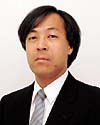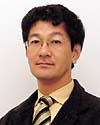 |
Hirotaka MARUYAMA,
Senior Research Engineer,
Advanced Imaging Devices |
Our study group has been developing high-performance imaging devices such as the Solid-state HARP* Imaging Device, which has ten times the sensitivity of an ordinary CCD (Charge Coupled Device) and a wide dynamic range.
The structure of the Solid-state HARP Imaging Device features a crimp junction in which bump electrodes are sandwiched between an optoelectronic-conversion section and a signal-readout circuit. To obtain a sensitivity high enough to get clear images in darkness, the optoelectronic-conversion section employs a HARP film that has a high quantum efficiency and an amplification effect with no added noise.
Work also continues on a low-noise signal-readout circuit needed for raising sensitivity. The junction section has fine bumps and electrodes for each pixel and pressure, and the state of junction surfaces, etc., are optimized at the time of bonding to ensure the reliability of the device.
Furthermore, a signal-processing circuit is being incorporated in the imaging device to obtain a wide dynamic range for pickup over a broad range of lighting conditions. Here, signal saturation when particularly intense light is incident is a problem, and new technology that makes for a more accurate output under intense light is being developed.
In the above manner, by combining the high-sensitivity, optoelectronic-conversion technology of the HARP film, new low-noise technology, and wide-dynamic-range technology, we are making definite progress towards the realization of next-generation high-performance solid-state imaging devices.
*HARP: High-gain Avalanche Rushing amorphous Photoconductor
|


